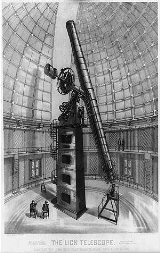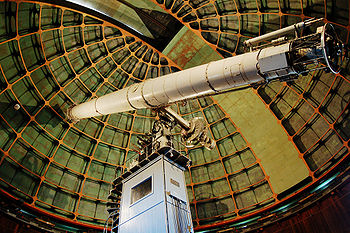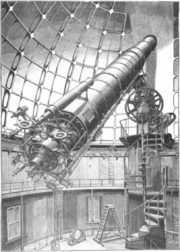
James Lick telescope
Encyclopedia
The James Lick Telescope is an antique refracting
36 inch (91.4 cm) telescope
built in 1889 that can still be viewed through today (public viewing is allowed on a limited basis). Also called the "Great Lick Refractor" or simply "Lick Refractor", it is the third-largest refracting telescope in the world, surpassed by the Yerkes Observatory
40-inch and the Swedish 1-m Solar Telescope
, and was the largest until 1897. It is located at the University of California's
Lick Observatory
atop Mount Hamilton
at an elevation of 4,209 feet (1,283 m) above sea level. The telescope is housed inside a dome which is powered by hydraulics to raise and lower the floor, rotate the dome, and drive the clock mechanism to track the Earth's rotation. The original hydraulic system still operates today, with the exception that the original wind-powered pumps to fill the reservoirs have been replaced with electric pumps. James Lick
is himself entombed
below the telescope's observing room's floor.
Here are some excerpts from the July 1902 description of the telescope (out of copyright):
 The fabrication of the objective lens, a two element achromat, the largest lens ever made at the time, caused years of delay. The famous large telescope maker Alvan Clark
The fabrication of the objective lens, a two element achromat, the largest lens ever made at the time, caused years of delay. The famous large telescope maker Alvan Clark
was in charge of the optical design. He gave the contract for casting the high quality optical glass blanks, of a size never before attempted, to the firm of Charles Feil in Paris. One of the huge glass disks broke during shipping, and making a replacement was delayed. Finally, after 18 failed attempts, the lens was finished, transported safely across country, and on December 31, 1888, was carefully installed in the telescope tube. The builders had to wait for 3 days for a break in the clouds to test it. On the evening of January 3 the telescope saw 'first light'—and they found that the instrument couldn't be focused. An error in the estimate of the lens' focal length
caused the tube to be built too long. A hacksaw was sent for, the great tube was unceremoniously cut back to the proper length, and the star Aldebaran
came into focus.
 These are some of the discoveries made with the Lick telescope:
These are some of the discoveries made with the Lick telescope:
Refracting telescope
A refracting or refractor telescope is a type of optical telescope that uses a lens as its objective to form an image . The refracting telescope design was originally used in spy glasses and astronomical telescopes but is also used for long focus camera lenses...
36 inch (91.4 cm) telescope
Telescope
A telescope is an instrument that aids in the observation of remote objects by collecting electromagnetic radiation . The first known practical telescopes were invented in the Netherlands at the beginning of the 1600s , using glass lenses...
built in 1889 that can still be viewed through today (public viewing is allowed on a limited basis). Also called the "Great Lick Refractor" or simply "Lick Refractor", it is the third-largest refracting telescope in the world, surpassed by the Yerkes Observatory
Yerkes Observatory
Yerkes Observatory is an astronomical observatory operated by the University of Chicago in Williams Bay, Wisconsin. The observatory, which calls itself "the birthplace of modern astrophysics," was founded in 1897 by George Ellery Hale and financed by Charles T. Yerkes...
40-inch and the Swedish 1-m Solar Telescope
Swedish Solar Telescope
The Swedish 1-m Solar Telescope is a refracting solar telescope at Roque de los Muchachos Observatory, La Palma in the Canary Islands. It is run by the Institute for Solar Physics of the Royal Swedish Academy of Sciences. The primary element is a single fused silica lens, making it the second...
, and was the largest until 1897. It is located at the University of California's
University of California
The University of California is a public university system in the U.S. state of California. Under the California Master Plan for Higher Education, the University of California is a part of the state's three-tier public higher education system, which also includes the California State University...
Lick Observatory
Lick Observatory
The Lick Observatory is an astronomical observatory, owned and operated by the University of California. It is situated on the summit of Mount Hamilton, in the Diablo Range just east of San Jose, California, USA...
atop Mount Hamilton
Mount Hamilton (California)
Mount Hamilton is a mountain in California's Diablo Range, in Santa Clara County, California. Mount Hamilton, at is the tallest mountain overlooking Silicon Valley, and is the site of Lick Observatory, the first permanently occupied mountain-top observatory. The various summits along its...
at an elevation of 4,209 feet (1,283 m) above sea level. The telescope is housed inside a dome which is powered by hydraulics to raise and lower the floor, rotate the dome, and drive the clock mechanism to track the Earth's rotation. The original hydraulic system still operates today, with the exception that the original wind-powered pumps to fill the reservoirs have been replaced with electric pumps. James Lick
James Lick
James Lick was an American carpenter, piano builder, land baron, and patron of the sciences. At the time of his death, he was the wealthiest man in California, and left the majority of his estate to social and scientific causes.-Early years:James Lick was born in Stumpstown Pennsylvania on August...
is himself entombed
Tomb
A tomb is a repository for the remains of the dead. It is generally any structurally enclosed interment space or burial chamber, of varying sizes...
below the telescope's observing room's floor.
Here are some excerpts from the July 1902 description of the telescope (out of copyright):
- The height of the marble floor of the main building above mean sea level is 4209 feet. On a closely connected peak half a mile to the east of the Observatory, and 50 feet higher, are the reservoirs from which water for household and photographic purposes is distributed. A spring about 350 feet below and one mile to the northeast of the Observatory supplies excellent water. Another peak seven-eighths of a mile to the east is the summit of Mount Hamilton; it is 180 feet higher than the Observatory, and supports the reservoirs supplying power for moving the dome, raising the movable floor, and winding the driving clock of the great telescope. This system receives its supply from the winter rains falling on the roofs; the water being pumped to the reservoirs on the higher peak by means of windmills.
- The movable floor in the dome is the first of the kind to be constructed. It is 60 feet (18 m) in diameter, and can be raised or lowered through a distance of 16½ feet (5.0 m), its purpose being to bring the observer within convenient reach of the eye end of the telescope.
Construction

Alvan Clark
Alvan Clark , born in Ashfield, Massachusetts, the descendant of a Cape Cod whaling family of English ancestry, was an American astronomer and telescope maker. He was a portrait painter and engraver , and at the age of 40 became involved in telescope making...
was in charge of the optical design. He gave the contract for casting the high quality optical glass blanks, of a size never before attempted, to the firm of Charles Feil in Paris. One of the huge glass disks broke during shipping, and making a replacement was delayed. Finally, after 18 failed attempts, the lens was finished, transported safely across country, and on December 31, 1888, was carefully installed in the telescope tube. The builders had to wait for 3 days for a break in the clouds to test it. On the evening of January 3 the telescope saw 'first light'—and they found that the instrument couldn't be focused. An error in the estimate of the lens' focal length
Focal length
The focal length of an optical system is a measure of how strongly the system converges or diverges light. For an optical system in air, it is the distance over which initially collimated rays are brought to a focus...
caused the tube to be built too long. A hacksaw was sent for, the great tube was unceremoniously cut back to the proper length, and the star Aldebaran
Aldebaran
Aldebaran is a red giant star located about 65 light years away in the zodiac constellation of Taurus. With an average apparent magnitude of 0.87 it is the brightest star in the constellation and is one of the brightest stars in the nighttime sky...
came into focus.
Major discoveries

- AmaltheaAmalthea (moon)Amalthea is the third moon of Jupiter in order of distance from the planet. It was discovered on September 9, 1892, by Edward Emerson Barnard and named after Amalthea, a nymph in Greek mythology. It is also known as '....
, the fifth satellite of Jupiter was discovered in September, 1892. It revolves around the planet once in 11h 57m 22.6s, and is probably about 100 miles in diameter. It is so difficult to observe that, besides members of the Lick Observatory staff, probably not more than twenty people have seen it. - The speed of the planetary nebulae in their motions through space is of the same order of magnitude as the speed of the stars.
- Twenty-five cometCometA comet is an icy small Solar System body that, when close enough to the Sun, displays a visible coma and sometimes also a tail. These phenomena are both due to the effects of solar radiation and the solar wind upon the nucleus of the comet...
s—17 unexpected and 8 periodic—have been discovered. - The unequaled Lick series of comet photographs has taught us more as to the structure, formation, and dissolution of comets' tails than had been learned in all previous time.
- About 1300 new double starDouble starIn observational astronomy, a double star is a pair of stars that appear close to each other in the sky as seen from Earth when viewed through an optical telescope. This can happen either because the pair forms a binary star, i.e...
s have been discovered. - The period of revolution of the double star delta EquuleiDelta EquuleiDelta Equulei is the second brightest star in the constellation Equuleus. Delta Equulei is a binary star system about 60 light years away, with components of class G0 and F5. Their combined magnitude is 4.47, and their absolute magnitude is 3.142. There is controversy as to the exact masses of the...
has been shown to be 5 3/4 years, the shortest period previously known for any double star being 11.4 years. It is therefore in many ways the most interesting double star under observation. - Spectroscopic observations have shown that the atmosphereAtmosphereAn atmosphere is a layer of gases that may surround a material body of sufficient mass, and that is held in place by the gravity of the body. An atmosphere may be retained for a longer duration, if the gravity is high and the atmosphere's temperature is low...
of MarsMarsMars is the fourth planet from the Sun in the Solar System. The planet is named after the Roman god of war, Mars. It is often described as the "Red Planet", as the iron oxide prevalent on its surface gives it a reddish appearance...
is of low density—probably much less dense at the surface of Mars than the Earth's atmosphere at the summit of the highest peak in the HimalayasHimalayasThe Himalaya Range or Himalaya Mountains Sanskrit: Devanagari: हिमालय, literally "abode of snow"), usually called the Himalayas or Himalaya for short, is a mountain range in Asia, separating the Indian subcontinent from the Tibetan Plateau...
. - The average speed of the brighter stars is 21 mi/s.
- The North Polar StarPolarisPolaris |Alpha]] Ursae Minoris, commonly North Star or Pole Star, also Lodestar) is the brightest star in the constellation Ursa Minor. It is very close to the north celestial pole, making it the current northern pole star....
was found to be a triple star, in 1899, by means of spectroscopic observations. Two of its members are invisible in our largest telescopes. The bright star and one dark companion revolve around each other in four days; and these in turn revolve around the other dark body in several years. - CapellaCapella (star)Capella is the brightest star in the constellation Auriga, the sixth brightest star in the night sky and the third brightest star in the northern celestial hemisphere, after Arcturus and Vega. Although it appears to be a single star to the naked eye, it is actually a star system of four stars in...
was discovered, in 1899, to be a spectroscopic binary star, period 104 days, the two nearly equal components being inseparable in our largest telescopes. - About 40 spectroscopic binaries—that is, stars seen single in ordinary telescopes, but proven to be double by means of the spectroscope—were discovered in 1898-1902. At least one star in seven has an invisible component, observable thus far only by spectroscopic means.
- About 10,000 nebulae have been discovered in the past at the various observatories; but the Lick photographs show that fully 100,000 nebulae await discovery. These photographs led to the unexpected discovery that the majority of the nebulae have a spiral form—undoubted evidence of their rotation.
- The light of the inner portion of the solar coronaCoronaA corona is a type of plasma "atmosphere" of the Sun or other celestial body, extending millions of kilometers into space, most easily seen during a total solar eclipse, but also observable in a coronagraph...
is largely inherent, whereas the light of the outer portion is largely reflected sunlight, as proven at the SumatraSumatraSumatra is an island in western Indonesia, westernmost of the Sunda Islands. It is the largest island entirely in Indonesia , and the sixth largest island in the world at 473,481 km2 with a population of 50,365,538...
eclipse by means of spectroscopic and polariscopic observations. - It has been shown that the principal "New Stars" have been converted into nebulae.
- The extraordinary motion in the nebula surrounding Nova Persei was discovered from the photograph of November 7–8, 1901.
- Many thousands of very accurate positions of stars have been secured with the meridian circleMeridian circleThe meridian circle, transit circle, or transit telescope is an instrument for observing the time of stars passing the meridian, at the same time measuring its angular distance from the zenith...
. - Very extensive and accurate observations of double stars, comets, planetPlanetA planet is a celestial body orbiting a star or stellar remnant that is massive enough to be rounded by its own gravity, is not massive enough to cause thermonuclear fusion, and has cleared its neighbouring region of planetesimals.The term planet is ancient, with ties to history, science,...
s, etc., have been made. - Very extensive additions have been made to our knowledge of the spectra of nebulae, of comets, of new stars, of bright-line stars, etc.
- The speeds in the line of sight of about four hundred of the brighter stars in the northern sky have been measured by means of the spectroscope.

